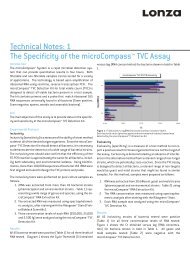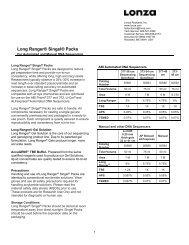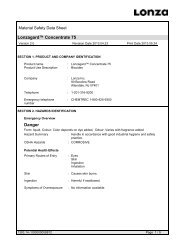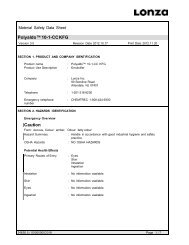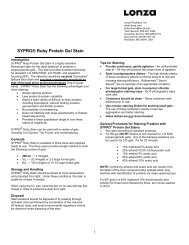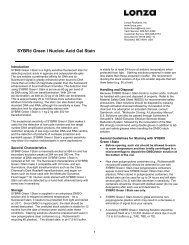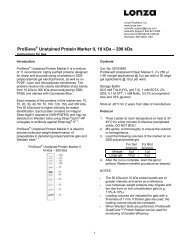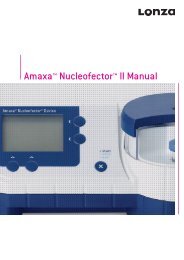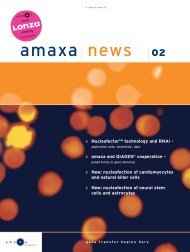amaxa news #10 - Lonza AG
amaxa news #10 - Lonza AG
amaxa news #10 - Lonza AG
Create successful ePaper yourself
Turn your PDF publications into a flip-book with our unique Google optimized e-Paper software.
› FAQ<br />
FAQs on Nucleofection ® and<br />
Preservation of Functionality<br />
› Are the rat and mouse hepatocytes still<br />
functional after nucleofection ® ?<br />
›› Yes, transfected mouse hepatocytes show<br />
albumin synthesis rates comparable to those<br />
of untransfected cells. Moreover, the morphology<br />
and polarization of rat hepatocytes is not<br />
affected by nucleofection ® .<br />
› Are there any effects on the differentiation<br />
of neural stem cells following nucleofection ® ?<br />
›› The ability of transfected rat or mouse neural<br />
stem cells to be subsequently differentiated<br />
into a variety of cell types is well documented<br />
in scientific literature, for example:<br />
› Nucleofection ® of neural stem cells (NSC)<br />
does not affect their functionality or impinge<br />
on their ability to be subsequently differentiated<br />
into oligodendrocytes [Copray et al.<br />
(2006) Stem Cells 24(4): 1001-1010].<br />
› Have you analyzed whether nucleofection ®<br />
influences differentiation in mouse ES cells?<br />
›› During the optimization process of a<br />
Nucleofector ® Protocol, great care is taken<br />
about preservation of functionality of the<br />
cells post transfection. Internal experiments<br />
showed that nucleofection ® does not alter the<br />
differentiation ability of mouse ES. This was<br />
investigated by analyzing the expression level<br />
of the transcription factor GATA-6. Results<br />
have also shown that the differentiation process<br />
itself is not triggered by nucleofection ® .<br />
This is well documented in literature showing<br />
unaltered differentiation potential of mouse<br />
ES cells, e.g. (Lakshmipathy et al., Stem Cells<br />
22:531-543).<br />
› Page 21 › www.<strong>amaxa</strong>.com<br />
› Have you tested whether transfected macrophages<br />
maintain functionality?<br />
›› Yes, we analyzed the secretion of TNF-a triggered by stimulation<br />
of the cells with LPS 24 hours post nucleofection ® . In comparison<br />
to the untransfected control, the functionality is 70%.<br />
› Is it possible to stimulate transfected T cells?<br />
›› Yes, transfected resting T cells can be stimulated post<br />
nucleofection ® . It is important to wait at least 4 hours before<br />
stimulation (e.g., incubation in Human T Cell Medium provided<br />
by <strong>amaxa</strong>). Stimulating immediately after nucleofection ® may<br />
lead to increased cell mortality and poor activation of cells.<br />
For optimal stimulation of the transfected cells, we recommend<br />
coating 96-well plates for stimulation with a solution of<br />
anti-CD3 antibody [OKt 3; eBioscience, Cat. No. 14-0037-82]<br />
and anti-CD28 antibody [15E8; Research Diagnostics Inc.,<br />
Cat. No. RD1-111650clb]. For stimulated cells, maintenance of the<br />
stimulated state was analyzed by expression of CD25 as well as<br />
the secretion of interferon gamma.<br />
› Is it possible to transfect mRNA of tumor cells into<br />
antigen-presenting cells like B cells or dendritic cells<br />
with the Nucleofector ® Technology?<br />
›› Yes. Recently Coughlin and co-workers showed that RNA<br />
transfected CD40-activated B cells or DCs induce functional<br />
T cell responses against viral and tumor antigen targets<br />
(Coughlin et al. (2004) Blood 103:2046-2054).<br />
In short, the authors found:<br />
› mRNA uptake in B cells and dendritic cells up to 80%.<br />
› CD40-activated B cells or dendritic cells induce functional<br />
T cell responses against viral and tumor antigen targets.<br />
› mRNA transfection is less toxic and gave higher efficiencies.<br />
<strong>amaxa</strong> web information www.<strong>amaxa</strong>.com/faq



